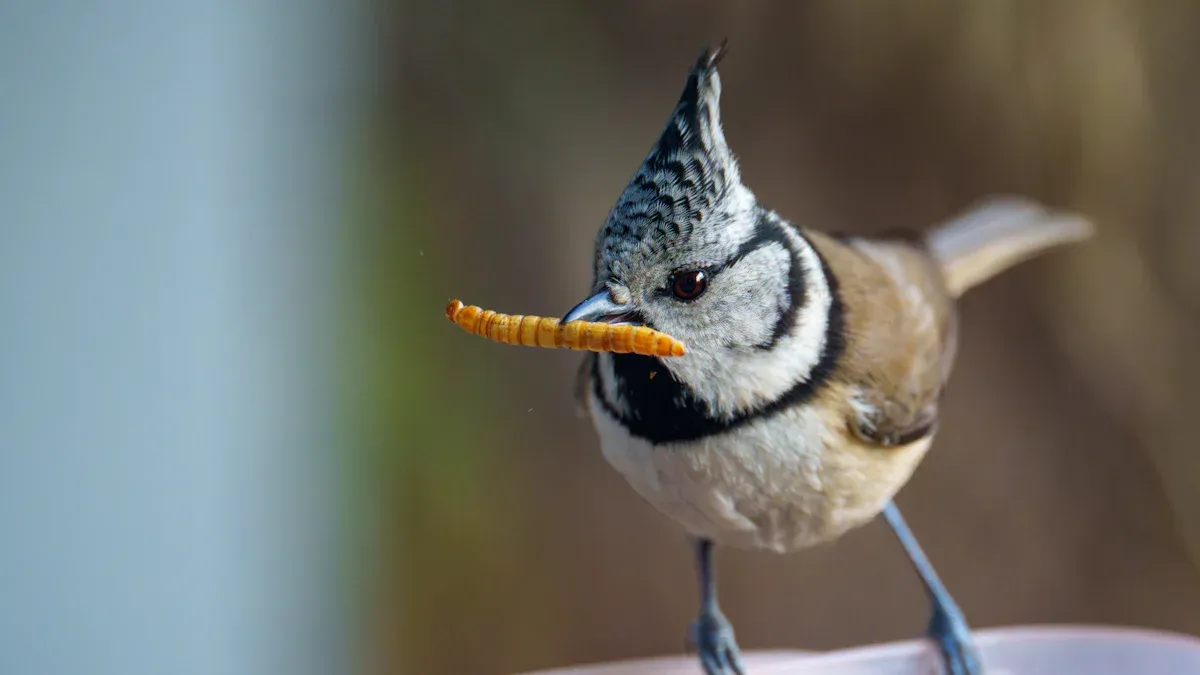
Bird Seed Mealworms turn an ordinary bird snack into a powerhouse treat. Birds gobble them up for their rich protein (up to 53%), healthy fats, and a mix of vitamins and minerals like B12, zinc, and magnesium.
- Protein levels soar as high as 51.69 mg/g, depending on diet.
- Mealworms offer omega-3s and antioxidants for extra pep.
Every batch of our dried mealworms comes preservative-free and additive-free, ensuring birds get a natural, high-quality feast.
Key Takeaways
- Bird seed mealworms provide birds with high protein, healthy fats, and essential vitamins that help them grow strong, stay energized, and maintain shiny feathers.
- Adding mealworms to bird feeders supports birds’ immune systems and helps them recover from stress and illness, keeping backyard birds healthy and active.
- Feeding birds about 5% of their daily food as mealworms once a day offers the best balance of nutrition and energy without overfeeding, making mealworms a perfect supplement to seeds.
What Are Bird Seed Mealworms?
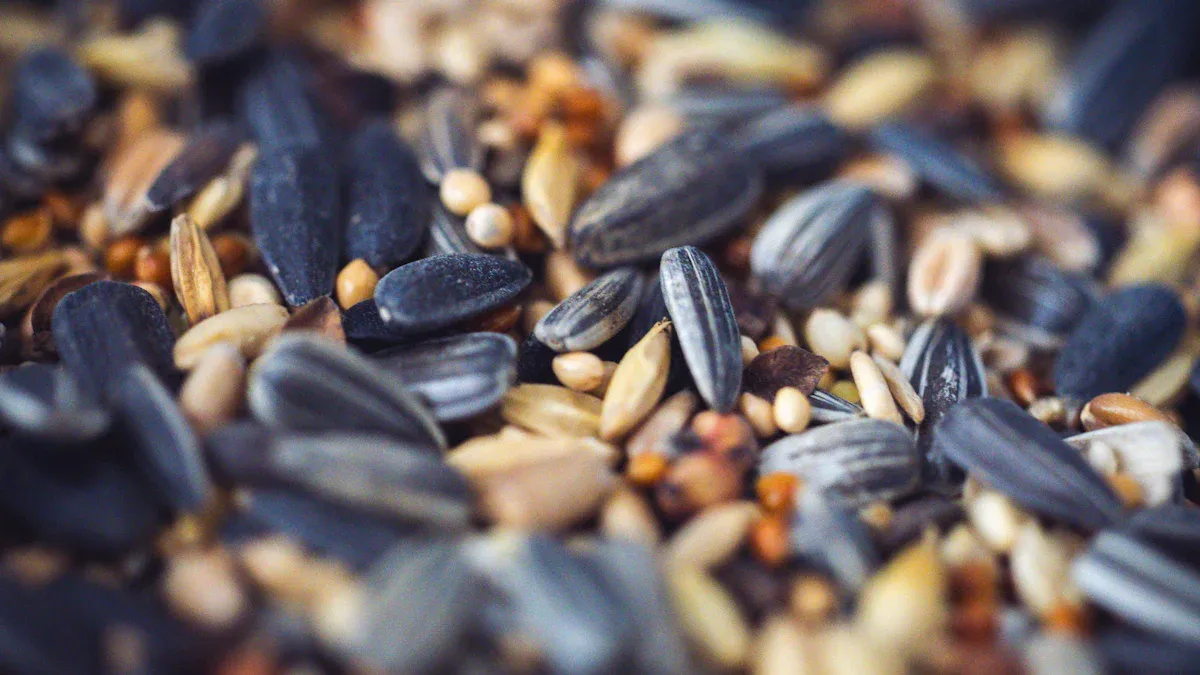
Definition and Source of Mealworms
Mealworms look like tiny, wiggly noodles, but they pack a punch for hungry birds. These little creatures are actually the larval stage of the beetle Tenebrio molitor. Farmers raise them with great care, making sure they stay healthy and plump. Once grown, mealworms get dried to lock in their nutrition. Dried mealworms become a favorite snack for birds, reptiles, and even some fish.
Fun fact: Dried mealworms contain no preservatives or additives, so birds get a pure, natural treat every time.
Our company specializes in breeding high-quality yellow mealworms. Each batch gets checked for freshness and nutrition. Birds love the taste, and owners love the peace of mind.
Role in Bird Seed Mixes
Bird Seed Mealworms turn an ordinary seed mix into a feast fit for a feathered king. Birds need more than just seeds. They crave protein, healthy fats, and minerals, especially during tough times like winter or nesting season. Mealworms deliver all that and more.
| Nutrient | Fresh Mealworms (%) | Dried Mealworms (%) |
|---|---|---|
| Protein | 17.6 | 49.1 |
| Fat | 13.8 | 38.3 |
| Moisture | 64.1 | N/A |
| Carbohydrate | 3.1 | 8.5 |
| Ash (minerals) | 1.5 | 4.1 |
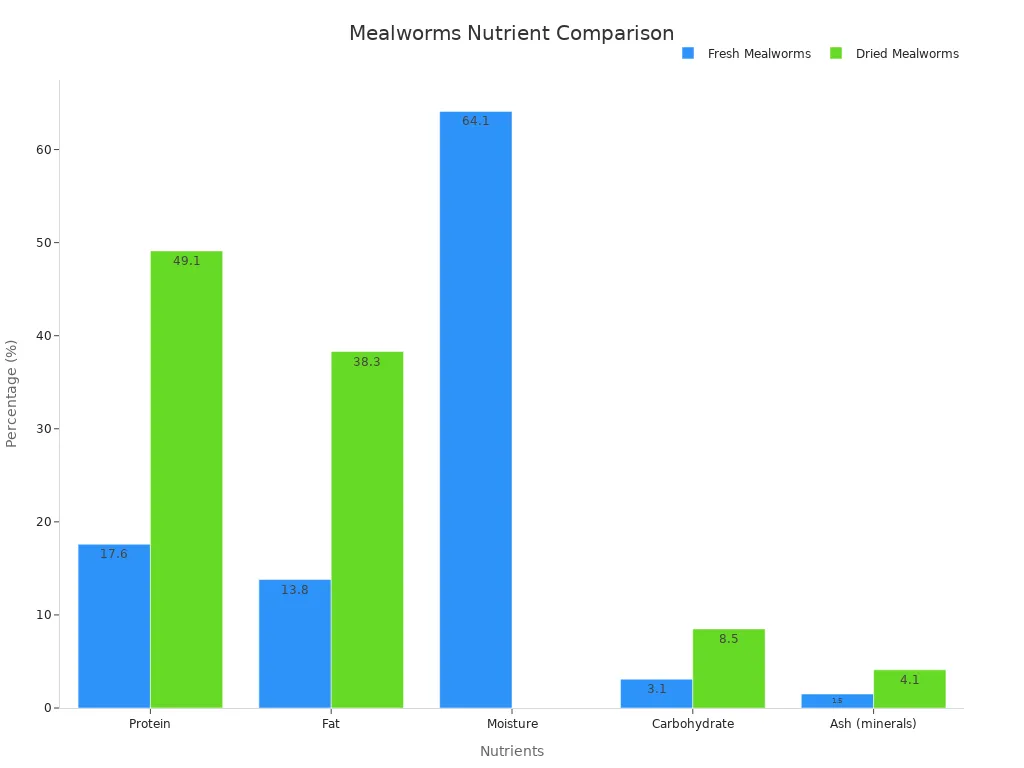
Researchers have watched bluebirds gobble up mealworms to build muscle, grow shiny feathers, and stay energized. Mealworms help birds survive cold snaps and keep flocks happy. Experts suggest adding mealworms to seed mixes, especially when birds need extra fuel. With Bird Seed Mealworms, every bite brings birds closer to their best health.
Nutritional Profile of Bird Seed Mealworms
Protein Content and Amino Acids
Birds need protein to grow strong, flap their wings, and sing their best songs. Mealworms deliver a protein punch that seeds alone just can’t match. Scientists have measured the protein in mealworms and found it stays high, even when the worms eat different diets. The protein content remains steady, and the amino acid profile covers all the essentials birds need for muscle and feather growth.
| Diet Type | Crude Protein Content | Amino Acid Profile Highlights |
|---|---|---|
| Standard Control Diet | High | All essential amino acids present |
| Mixed Soy, Maize, Stover | High | Comparable to control diet |
| 100% Stover Diet | Maintained | Nutrient content stays strong across generations |
Mealworms also offer highly digestible protein. Studies show that birds can absorb about 86% of the amino acids from mealworms. That means less waste and more nutrition in every bite. No wonder birds go wild for them!
Note: Our dried mealworms keep all this protein goodness locked in, making them a top choice for bird lovers who want to see their feathered friends thrive.
Healthy Fats and Energy
Birds burn a lot of energy, especially during migration or chilly nights. Mealworms come packed with healthy fats—about 33% of their body weight! These fats include omega-9, omega-6, and omega-3 fatty acids. Birds that eat mealworms store these fats in their bodies, giving them a steady fuel supply for long flights or busy days.
| Fatty Acid Type | MUFA Diet (with mealworms) | PUFA Diet (with mealworms) |
|---|---|---|
| Omega-9 (18:1) | 70.65% | 51.70% |
| Omega-6 (18:2) | 14.65% | 29.34% |
| Omega-3 (18:3) | 0.50% | 4.11% |
Birds fed with more omega-6 and omega-3 from mealworms use less energy during long flights. In fact, some birds saved up to 11% of their energy on a 260-kilometer journey. That’s like a runner getting a boost from a secret snack!
Tip: Adding Bird Seed Mealworms to your feeder helps birds stay energized and ready for adventure.
Vitamins and Minerals
Mealworms don’t just stop at protein and fat. They also bring a treasure chest of vitamins and minerals to the table. Birds get a healthy dose of B vitamins, especially vitamin B12, which helps with energy and nerve health. The mineral lineup includes zinc, copper, magnesium, and manganese—each one important for strong bones, sharp minds, and shiny feathers.
| Nutrient | Concentration Range (per dry matter) |
|---|---|
| Vitamin B12 | 0.47 µg |
| Thiamine (B1) | 0.1 to 7.7 mg |
| Riboflavin (B2) | 0.11 to 8.9 mg |
| Zinc | 7.1 to 56.2 mg/kg |
| Copper | 1.2 to 8.3 mg/kg |
| Magnesium | 50 to 620 mg/kg |
| Manganese | 2.7 to 61.8 mg/kg |
Birds munching on mealworms get the nutrients they need for healthy bodies and beautiful plumage. With every bite, they build up their defenses and sparkle in the sunlight.
Birds love the taste, and their bodies love the nutrition. That’s the magic of mealworms!
Bird Wellness Benefits of Mealworms
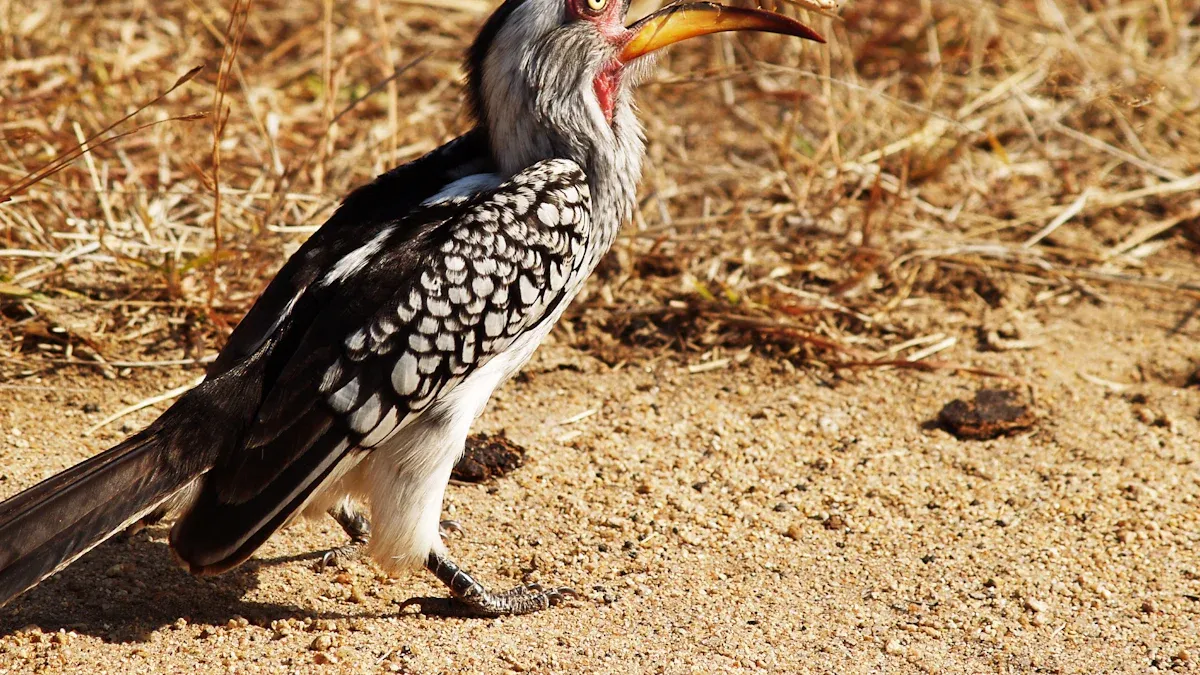
Growth and Development Support
Birds grow fast. They need strong muscles, sturdy bones, and lots of energy. Mealworms help them reach their full size and strength. In one study, scientists watched 1,000 baby chicks eat diets with a sprinkle of mealworms. The chicks grew bigger and stronger than those without mealworms. Their bodies packed on healthy weight. Their bones felt solid. Their feathers looked fuller. The secret? Mealworms bring a natural mix of protein, vitamins, and special nutrients that help birds grow up healthy.
Bird Seed Mealworms work like a superfood for young birds. They deliver the building blocks for growth. Even a small amount in the diet makes a big difference. Birds that munch on mealworms stand tall and proud. They flap their wings with power. They explore their world with confidence.
Birds that eat mealworms as chicks often become the strongest flyers in the flock.
Immune System Enhancement
Birds face many challenges in the wild. Germs, stress, and changing weather can make them sick. Mealworms help birds fight back. These tiny treats contain antimicrobial peptides—natural defenders that boost the immune system. Birds that eat mealworms build stronger shields against illness.
In the same study with the chicks, researchers noticed something amazing. The birds with mealworms in their diet had healthier blood and stronger immune traits. Their bodies fought off sickness better. Their organs worked smoothly. Mealworms gave them the tools to stay healthy, even when life got tough.
- Mealworms help birds:
- Fight off infections
- Recover faster from stress
- Stay active and alert
Bird Seed Mealworms offer a simple way to keep backyard birds healthy and happy. A handful in the feeder can make a big difference.
Feather Health and Molting
Feathers do more than look pretty. They keep birds warm, help them fly, and protect their skin. When birds molt, they shed old feathers and grow new ones. This process takes a lot of energy and nutrients. Mealworms step in to help.
Packed with protein and healthy fats, mealworms give birds the fuel they need for shiny, strong feathers. Birds that snack on mealworms during molting grow new feathers faster. Their plumage shines in the sunlight. Their wings slice through the air with ease.
| Feather Benefit | How Mealworms Help |
|---|---|
| Faster feather growth | Extra protein and energy |
| Brighter colors | More vitamins and minerals |
| Stronger structure | Balanced amino acids |
Tip: Offer mealworms during molting season. Watch your birds transform into their most colorful, vibrant selves!
Bird Seed Mealworms vs. Other Bird Seed Ingredients
Advantages Over Seeds
Seeds fill bird feeders everywhere. They offer energy and crunch. But mealworms bring something extra to the table. Birds get more than just a snack—they get a super snack! Mealworms burst with protein. Seeds can’t keep up. Birds need protein for strong muscles and shiny feathers. Mealworms deliver that in every bite.
Check out this quick comparison:
| Feature | Seeds | Mealworms |
|---|---|---|
| Protein | Low to Medium | Very High |
| Fat | Medium | High |
| Vitamins | Some | Many |
| Minerals | Some | Many |
Birds love the taste of mealworms. They gobble them up faster than sunflower seeds. During cold months, birds need extra energy. Mealworms help them stay warm and active. Seeds alone just can’t do the job.
Comparison with Other Protein Sources
Birds sometimes find protein in suet, peanuts, or even insects in the wild. But dried mealworms stand out. Suet melts in the sun. Peanuts can spoil. Mealworms stay fresh and tasty. They come preservative-free and additive-free. That means birds get pure nutrition every time.
- Mealworms offer:
- Easy digestion
- No mess
- Long shelf life
Birds at the feeder cheer for mealworms. They know a good thing when they see it!
Feeding Bird Seed Mealworms: Practical Tips
Recommended Amounts and Frequency
Birds love mealworms, but they need just the right amount to stay healthy and happy. Studies show that feeding birds about 5% of their daily food as mealworms works best. This small boost gives them extra protein and energy without overdoing it. Most experts suggest offering mealworms once a day. Some birds get even more excited when they see mealworms twice a day, but too much can slow their growth.
Here’s a quick look at what researchers found:
| Study / Species | Mealworm Supplementation Level | Frequency | Key Findings |
|---|---|---|---|
| Bellezza Oddon et al. | 5% of expected average daily feed intake (ADFI) | Once daily | Improved feed conversion ratio in broiler chickens; no negative effect on growth performance |
| Ipema et al. | 5% and 10% of estimated daily dry matter intake (DM) | Twice daily (tested) | 10% DM larvae led to lower final live weight than 5% or control; more active behavior with higher amounts and frequency |
| Bongiorno et al. | 10% of expected ADFI | Once daily | No effect on live weight, average daily gain, or feed intake in Label Necked Neck chickens |
| Muscovy ducks | ~5% of expected ADFI | Once daily | No negative effect on growth; final live weight 9% higher than guidelines; welfare benefits |
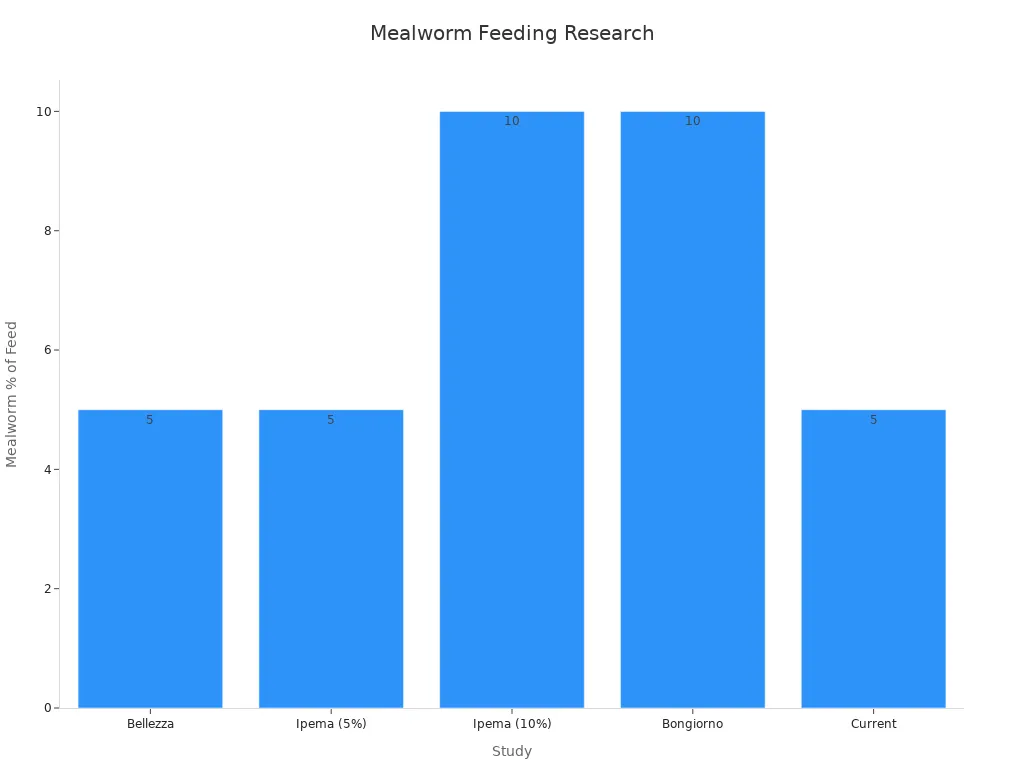
Birds thrive with a sprinkle of mealworms in their daily routine. Too many can spoil the fun, so stick to the golden 5% rule for best results.
Bird Species That Benefit Most
Not all birds eat the same way. Some species leap for joy at the sight of mealworms. Great tits, for example, grow bigger and stronger when they get mealworms, especially in cities where bugs are hard to find. House sparrows also raise more chicks when mealworms join the menu. These birds show off plumper nestlings and better survival rates.
Tufted titmice and other North American parids have a knack for finding mealworms in feeders. They use clever tricks to grab these tasty treats. Each species brings its own style to the table, but all enjoy the boost that mealworms provide.
Tip: Watch your backyard. If you spot great tits, house sparrows, or titmice, toss in some mealworms and enjoy the show!
Bird Seed Mealworms turn every bird feeder into a wellness buffet. Birds thrive with better immunity, stronger feathers, and more energy.
- Mealworms boost gut health and help birds fight disease.
- Birds enjoy high protein and easy digestion.
- Mealworms offer a natural, sustainable snack.
FAQ
Do birds really love mealworms?
Birds go wild for mealworms! They swoop in, snatch them up, and sometimes even do a happy dance at the feeder.
Can dried mealworms replace all other bird food?
Nope! Mealworms work best as a tasty supplement. Birds still need seeds, fruits, and other goodies for a balanced diet.
Are your dried mealworms safe for wild birds?
Absolutely! The dried mealworms come preservative-free and additive-free. Birds get pure, natural nutrition in every crunchy bite.


